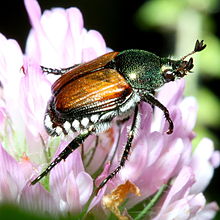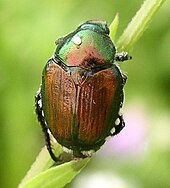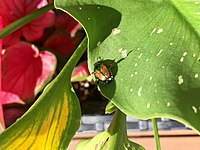Japanese beetle
| Japanese beetle | |
|---|---|

| |
| Scientific classification | |
| Domain: | Eukaryota |
| Kingdom: | Animalia |
| Phylum: | Arthropoda |
| Class: | Insecta |
| Order: | Coleoptera |
| Suborder: | Polyphaga |
| Infraorder: | Scarabaeiformia |
| Family: | Scarabaeidae |
| Genus: | Popillia |
| Species: | P. japonica
|
| Binomial name | |
| Popillia japonica Newman, 1841
| |
The Japanese beetle (Popillia japonica) is a species of scarab beetle. Due to the presence of natural predators, the Japanese beetle is not considered a pest in its native Japan, but in North America and some regions of Europe, it is a noted pest to roughly 300 species of plants. Some of these plants include rose bushes, grapes, hops, canna, crape myrtles, birch trees, linden trees, and others.[1]
The adult beetles damage plants by skeletonizing the foliage (i.e., consuming only the material between a leaf's veins) as well as, at times, feeding on a plant's fruit. The subterranean larvae feed on the roots of grasses.
Taxonomy
English entomologist Edward Newman described the Japanese beetle in 1841.[2]
Description
Adult P. japonica measure 15 mm (0.6 in) in length and 10 mm (0.4 in) in width, with iridescent copper-colored elytra and green thorax and head. A row of white tufts (spots) of hair project from under the wing covers on each side of the body.[3] Males are slightly smaller than females. Grubs are white and lie in curled positions. A mature grub is roughly 1 inch (2.5 cm) long.[4]
Distribution
Popillia japonica is native to Japan, but is an invasive species in North America and Europe.
The first written evidence of the insect appearing within the United States was in 1916 in a nursery near Riverton, New Jersey.[5] The beetle larvae are thought to have entered the United States in a shipment of iris bulbs prior to 1912, when inspections of commodities entering the country began. As of 2015, just nine western states of the United States were considered free of Japanese beetles.[4] These beetles have been detected in airports on the west coast of the United States since the 1940s. Only three were found in Washington State in 2020, but from late June to September 3, 2021, there were over 20,000 found in Grandview alone.[6]
The first Japanese beetle found in Canada was inadvertently brought by tourists to Yarmouth, Nova Scotia, by ferry from Maine in 1939. During the same year, three additional adults were captured at Yarmouth and three at Lacolle in southern Quebec.[7]
Japanese beetles have been found on the islands of the Azores since the 1970s.[8] In 2014, the first population in mainland Europe was discovered near Milan, Italy.[9][10] In 2017, the pest was detected in nearby Ticino, Switzerland.[11] In 2023, the first population north of the Alps was detected in Kloten near Zürich, Switzerland.[12]
Life cycle


Eggs are laid individually or in small clusters near the soil surface.[13] Within approximately two weeks, the ova hatch, then the larvae feed on fine roots and other organic material. As the larvae mature, they become c-shaped grubs, which consume progressively coarser roots and may do economic damage to pasture and turf at this time.
Larvae hibernate in small cells in the soil, emerging in the spring when soil temperatures rise again.[13] Within 4–6 weeks of breaking hibernation, the larvae will pupate. Most of the beetle's life is spent as a larva, with only 30–45 days spent as an imago. Adults feed on leaf material above ground, using pheromones to attract other beetles and overwhelm plants, skeletonizing leaves from the top of the plant downward. The aggregation of beetles will alternate daily between mating, feeding, and ovipositing. An adult female may lay as many as 40–60 ova in her lifetime.[13]
Throughout the majority of the Japanese beetle's range, its life cycle takes one full year; however, in the extreme northern parts of its range, as well as high-altitude zones as found in its native Japan, development may take two years.[14]
Pest control

Phenological models might be useful in predicting the timing of the presence of larvae or adults of the Japanese beetle. Model outputs can be used to support the timely implementation of monitoring and control actions against the pest, thus reducing its potential impact.[15][16]
Owing to their destructive nature, traps have been invented specifically to target Japanese beetles. These comprise a pair of crossed walls with a bag or plastic container underneath and are baited with floral scent, pheromone, or both. However, studies conducted at the University of Kentucky and Eastern Illinois University suggest beetles attracted to traps frequently do not end up in the traps; instead, they land on plants in the vicinity and cause more damage along the flight path and near the trap than may have occurred if the trap were not present.[17][18]
During the larval stage, the Japanese beetle lives in lawns and other grasslands, where it eats the roots of grasses. During that stage, it is susceptible to a fatal disease called milky spore disease, caused by a bacterium called milky spore, Paenibacillus (formerly Bacillus) popilliae. The USDA developed this biological control, and it is commercially available in powder form for application to lawn areas. Standard applications (low density across a broad area) take from two to four years to establish maximal protection against larval survival, expanding through the soil through repeated rounds of infection. Control programs based on milky spore disease have been found to work most efficiently when applied as large-scale treatment programs, rather than by isolated landowners. Bacillus thuringiensis is also used to control Japanese beetle populations in the same manner.[4]
On field crops such as squash, floating row covers can be used to exclude the beetles, but this may necessitate hand pollination of the flowers. Kaolin sprays can also be used as barriers and have been shown to be as effective as standard pesticides programs.[19]
Research performed by many US extension service branches has shown that pheromone traps attract more beetles than they catch; under favorable conditions, only up to three quarters of the insects attracted to a trap will be captured by it.[4][20] Traps are most effective when spread out over an entire community and downwind and at the borders (i.e., as far away as possible, particularly upwind) of managed property containing plants being protected.
When present in small numbers, the beetles may be manually controlled using a soap-water spray mixture, shaking a plant in the morning hours and disposing of the fallen beetles,[20] or simply picking them off attractions such as rose flowers, since the presence of beetles attracts more beetles to that plant.[21]
Several insect predators and parasitoids have been introduced to the United States for biocontrol. Two of them, the fly Istocheta aldrichi, a parasite of adult beetles, and the solitary wasp Tiphia vernalis, a parasite of larvae, are well established with significant but variable rates of parasitism. Tiphia vernalis reproduces by locating beetle grubs through digging, and on finding one, it paralyzes it with a sting and lays an egg on it; on hatching, the wasp larva consumes the grub. Istocheta aldrichi instead seeks out adult female beetles and lays eggs on their thoraxes, allowing its larvae to burrow into the insect's body and kill it in this manner. A female I. aldrichi can lay up to 100 eggs over two weeks, and the rapidity with which its larvae kill their hosts allows the use of these flies to suppress beetle populations before they can themselves reproduce.[4][22][23]
Soil-dwelling nematodes are known to seek out and prey on Japanese beetle grubs during the subterranean portion of their life cycle by entering larvae and reproducing within their bodies. Varieties that have seen commercial use as pest control agents include Steinernema glaseri and Heterorhabditis bacteriophora.[4]
Recent studies have begun to explore a microsporidian pathogen, Ovavesicula popilliae, as a form of biocontrol against Japanese beetles.[24] Initially discovered in 1987, O. popilliae has been observed inhabiting the malpighian tubules of third-instar larvae.[25] This leads to swelling, inefficiency in the gut, and potentially cause microsporidiosis in the infected beetles. This infection weakens the beetle and creates a suitable breeding ground for opportunistic pathogens.[24]
Host plants
While the larvae of Japanese beetles feed on the roots of many genera of grasses, the adults consume the leaves of a much wider range of hosts, including these common crops:[7] bean, cannabis, strawberry, tomato, pepper, grape, hop, rose, cherry, plum, pear, peach, raspberry, blackberry, corn, pea, okra, and blueberry.
List of adult beetle hostplant genera
- Abelmoschus (okra, musk mallow)
- Acer (maple)
- Aesculus (horse chestnut)
- Alcea (hollyhock)
- Aronia
- Asimina (pawpaw)
- Asparagus
- Aster
- Buddleja (butterfly bush)
- Calluna
- Caladium
- Canna
- Cannabis sativa
- Chaenomeles
- Castanea (sweet chestnut)
- Cirsium (thistle)
- Cosmos
- Dahlia
- Daucus (carrot)
- Dendranthema
- Digitalis (foxglove)
- Dioscorea (Yam)
- Dolichos
- Echinacea (coneflower)
- Hemerocallis (daylily)
- Heuchera
- Hibiscus
- Humulus (hop)
- Hydrangea
- Ilex (holly)
- Impatiens
- Ipomoea (sweet potato, morning glory)
- Iris
- Juglans (walnut)
- Lagerstroemia
- Liatris
- Ligustrum (privet)
- Malus (apple, crabapple)
- Malva (mallow)
- Mentha (mint)
- Myrica
- Ocimum (basil)
- Oenothera (evening primrose)
- Parthenocissus
- Phaseolus
- Phlox
- Physocarpus
- Pistacia
- Platanus (plane)
- Polygonum (Japanese knotweed)
- Populus (poplar)
- Prunus (plum, peach, etc.)
- Quercus (oak)
- Ribes (gooseberry, currants, etc.)
- Rheum (rhubarb)
- Rhododendron
- Rosa (rose)
- Rubus (raspberry, blackberry, etc.)
- Salix (willows)
- Sambucus (elder)
- Sassafras
- Solanum (nightshades, including potato, tomato, eggplant)
- Spinacia (spinach)
- Syringa (lilac)
- Thuja (arborvitae)
- Tilia (basswood, linden, UK: lime)
- Toxicodendron (poison oak, poison ivy, sumac)
- Ulmus (elm)
- Vaccinium (blueberry)
- Viburnum
- Vitis (grape)
- Weigelia
- Wisteria
- Zea (maize)
- Zinnia
Gallery
-
Japanese beetle larva (grub)
-
Japanese beetle pupa
-
Japanese beetle adult
-
Adult Japanese beetles feeding on peach tree
-
Feeding, Ottawa
-
Japanese beetle feeding on calla lily, Ottawa, Ontario, Canada
References
- ^ "Japanese beetle – Popillia japonica". entnemdept.ufl.edu. Retrieved 2023-03-14.
- ^ "ITIS - Report: Popillia japonica". www.itis.gov. Retrieved 2024-04-10.
- ^ M.F. Potter; D.A. Potter; L.H. Townsend (January 2006). "Japanese Beetles in the Urban Landscape". University of Kentucky, College of Agriculture. Archived from the original on 2018-09-08. Retrieved 2018-09-08.
- ^ a b c d e f "Managing the Japanese Beetle: A Homeowner' s Handbook" (PDF). www.aphis.usda.gov. United States Department of Agriculture Animal and Plant Health Inspection Service. Archived (PDF) from the original on 14 March 2023. Retrieved 31 Jan 2023.
- ^ "Japanese Beetle Ravages". Reading Eagle. 22 July 1923. p. 26. Archived from the original on 6 July 2020. Retrieved 28 September 2015.
- ^ "Japanese beetle count passes 20,000". WSDA AgBriefs. 3 September 2021. Archived from the original on 2021-09-16. Retrieved 2021-09-16.
- ^ a b "Popillia Japonica (Japanese Beetle) – Fact Sheet". Canadian Food Inspection Agency. 19 February 2014. Archived from the original on 4 December 2010. Retrieved 28 September 2015.
- ^ Virgílio Vieira (2008). "The Japanese beetle Popillia japonica Newman, 1838 (Coleoptera: Scarabaeidae) in the Azores islands" (PDF). Boletín Sociedad Entomológica Aragonesa. 43: 450. S2CID 83531725. Archived (PDF) from the original on 29 September 2015. Retrieved 28 September 2015.
- ^ "First report of Popillia japonica in Italy". EPPO. Archived from the original on 29 September 2015. Retrieved 28 September 2015.
- ^ "Popillia japonica Newman, 1841" (PDF) (in Italian). Assessorato Agricoltura, Caccia e Pesca, Regione Piemonte. Archived from the original (PDF) on 4 March 2016. Retrieved 28 September 2015.
- ^ "First report of Popillia japonica in Switzerland". EPPO. 2017. Archived from the original on 20 June 2018. Retrieved 19 June 2018.
- ^ "Invasive Art - Japankäfer in Kloten entdeckt: Kanton will Schädling tilgen". Schweizer Radio und Fernsehen (SRF) (in German). 2023-07-25. Retrieved 2023-07-25.
- ^ a b c Fleming, WE (1972). "Biology of the Japanese beetle". USDA Technical Bulletin. 1449.
- ^ ODA. "Or egon Department of Agriculture Insect Pest Prevention & Management Program Oregon.gov/ODA Rev: 3/ 30 /2017 2 Japanese Beetle Eradication Response Plan 2017" (PDF). www.oregon.gov/ODA/. Oregon Department of Agriculture. Archived (PDF) from the original on 7 July 2017. Retrieved 31 May 2017.
- ^ Gilioli, Gianni; Sperandio, Giorgio; Simonetto, Anna; Colturato, Michele; Battisti, Andrea; Mori, Nicola; Ciampitti, Mariangela; Cavagna, Beniamino; Bianchi, Alessandro; Gervasio, Paola (2021-09-20). "Modelling diapause termination and phenology of the Japanese beetle, Popillia japonica". Journal of Pest Science. 95 (2): 869–880. doi:10.1007/s10340-021-01434-8. hdl:11379/547495. ISSN 1612-4766. S2CID 239147213.
- ^ RÉgniÈre, Jacques; Rabb, Robert L.; Stinner, R. E. (1981-06-01). "Popillia japonica: Simulation of Temperature-Dependent Development of the Immatures, and Prediction of Adult Emergence". Environmental Entomology. 10 (3): 290–296. doi:10.1093/ee/10.3.290. ISSN 1938-2936.
- ^ "Japanese Beetles in the Urban Landscape". University of Kentucky. Archived from the original on 16 September 2015. Retrieved 28 September 2015.
- ^ Paul V. Switzer; Patrick C. Enstrom; Carissa A. Schoenick (2009). "Behavioral Explanations Underlying the Lack of Trap Effectiveness for Small-Scale Management of Japanese Beetles". Journal of Economic Entomology. 102 (3): 934–940. doi:10.1603/029.102.0311. PMID 19610405. S2CID 11509873. Archived from the original on 2017-09-22. Retrieved 2018-04-20.
- ^ Lalancette, Norman; Belding, Robert D; Shearer, Peter W; Frecon, Jerome L; Tietjen, William H (2005). "Evaluation of hydrophobic and hydrophilic kaolin particle films for peach crop, arthropod and disease management". Pest Management Science. 61 (1): 25–39. doi:10.1002/ps.943. ISSN 1526-498X. PMID 15593071.
- ^ a b "Japanese beetle control methods". Landscape America. Ohio City Productions, Inc. Archived from the original on 28 September 2015. Retrieved 28 September 2015.
- ^ Jeff Gillman (18 March 2010). "Disney and Japanese Beetles". Washington State University. Archived from the original on 14 March 2012. Retrieved 28 September 2015.
- ^ Rogers, Michael E.; Potter, Daniel A. (2004-06-01). "Biology of Tiphia pygidialis (Hymenoptera: Tiphiidae), a Parasitoid of Masked Chafer (Coleoptera: Scarabaeidae) Grubs, with Notes on the Seasonal Occurrence of Tiphia vernalis in Kentucky". Environmental Entomology. 33 (3): 520–527. doi:10.1603/0046-225X-33.3.520. ISSN 0046-225X.
- ^ Shanovich, Hailey N; Ribeiro, Arthur Vieira; Koch, Robert L (2021-04-01). "Seasonal Abundance, Defoliation, and Parasitism of Japanese Beetle (Coleoptera: Scarabaeidae) in Two Apple Cultivars". Journal of Economic Entomology. 114 (2): 811–817. doi:10.1093/jee/toaa315. ISSN 0022-0493. PMID 33503253.
- ^ a b Smitley, D; Hotchkiss, E; Buckley, K; Piombiono, M; Lewis, P; Studyvin, J (2022-06-07). "Gradual Decline of Japanese Beetle (Coleoptera: Scarabaeidae) Populations in Michigan Follows Establishment of Ovavesicula popilliae (Microsporidia)". Journal of Economic Entomology. 115 (5): 1432–1441. doi:10.1093/jee/toac085. ISSN 0022-0493. PMID 35671221.
- ^ ANDREADIS, THEODORE G.; HANULA, JAMES L. (February 1987). "Ultrastructural Study and Description of Ovavesicula popilliae N. G., N. Sp. (Microsporida: Pleistophoridae) from the Japanese Beetle, Popillia japonica (Coleoptera: Scarabaeidae)1". The Journal of Protozoology. 34 (1): 15–21. doi:10.1111/j.1550-7408.1987.tb03123.x. ISSN 0022-3921.
External links
- Japanese beetle on the UF/IFAS Featured Creatures Web site
- Japanese Beetle Archived 2009-04-18 at the Wayback Machine, Canadian Food Inspection Agency
- Organic methods of Japanese Beetle Control
- Species Profile – Japanese Beetle (Popillia japonica), National Invasive Species Information Center, United States National Agricultural Library.







